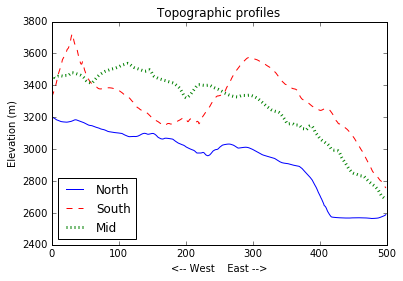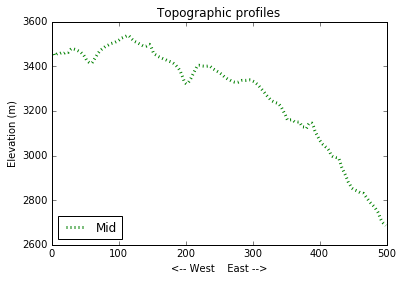Programming with Python
Writing stand-alone Python scripts
Learning Objectives
- Create
.pyfiles from Jupyter notebooks - Run Python scripts from the command line
- Understand the plotting memory buffer
- Save Matplotlib figures to file
We started out using the Jupyter (iPython) notebooks in these lessons because they are a friendly environment to try out individual commands and write short scripts. The Jupyter notebooks, however, can only run inside their specific graphical environment. Stand-alone Python programs are text files with the extension .py that are run from the command line or within an IDE (Integrated Development Environment) such as Spyder. Your Python code has to be in .py files to run on an HPCC.
The Jupyter notebooks are valuable in the early stages of your code development workflow, where you gradually build your program by tinkering with the code and exploring the data. However, you should quickly move your prototype code into stand-alone scripts that are platform independent and better suited for version control.
Before we dive further into Python, we are going to convert the scripts we wrote in the first lesson into stand-alone Python scripts that can run from the command line. We will first run this script locally (in your own computer) before moving it to beach.colorado.edu, the CSDMS HPCC, and running it on a remote server with the commands you learned during the Bash lessons.
Let’s look back at the script we wrote earlier that plots the West-to-East topographic profiles across our data. You should copy the code from the Jupyter notebook you were working in before to a new notebook to make sure nothing sneaks into the script:
import numpy as np
import matplotlib.pyplot as plt
%matplotlib inline
topo = np.loadtxt('data/topo.asc', delimiter=',')
plt.plot(topo[0,:], hold=True, label='North')
plt.plot(topo[-1,:], 'r--', label='South')
plt.plot(topo[len(topo)/2,:], 'g:', linewidth=3, label='Mid')
plt.title('Topographic profiles')
plt.ylabel('Elevation (m)')
plt.xlabel('<-- West East -->')
plt.legend(loc = 'lower left')
plt.show()
We can convert this code into a command-line Python script in two different ways:
- Export the Jupyter notebook as a
.pyfile [File -> Download As -> Python (.py)] - Copy the script and paste it into a simple text file (using a text editor like TextWrangler or Notepad++) and save the file with a
.pyextension
Go ahead and convert your Jupyter notebook into a .py file using whichever method is easier. Call your file topo_profiler.py and make sure that the file is in the same directory that contains the folder data where the file topo.asc is. Then open the file topo_profiler.py in your chosen text editor. Most code-friendly text editors will color the text in the file according to the language they are written in!
If you exported the file through the Jupyter notebook menu, any Markdown (text) cells should be prefixed with a #. These are comments and the Python interpreter will not read them. You should also see some lines that look like this: # In[ ]:. These are line numbers from the Jupyter notebook and are also commented out.
Open a new Bash window and navigate (using cd, ls and pwd) to the directory that contains your topo_profiler.py file. To run the script from the command line, type:
$ python topo_profiler.pyPython read the contents of the text file topo_profiler.py and tried to run the script, but it produced an error:
Traceback (most recent call last):
File "topo_profiler.py", line 19, in <module>
get_ipython().magic(u'matplotlib inline')
NameError: name 'get_ipython' is not definedIf you copied and pasted the code from the notebook to the text file instead of exporting it, it produced this error instead:
File "topo_profiler.py", line 20
%matplotlib inline
^
SyntaxError: invalid syntaxThe iPython magic command %matplotlib inline makes plots appear within the Jupyter notebook instead of in a separate window, but the regular Python interpreter doesn’t understand iPython magic commands. Go into the text file and comment out this line. In many text editors, the shortcut Command-/ (or Control-/) will comment out a line. You can also just add a # at the start of the line.
Now run the script again. Python opened up a window that shows the figure we could see inside the notebook. There are some tools along the bottom of this window that you can use to navigate and save the figure.
Notice that the Bash window doesn’t show a $ before the text prompt while the figure window is open. This shows that Bash is “busy” and won’t respond until you close the figure (you can open a new Bash window if you need to run something while the figure is open). The Python code is also paused – it will wait until the figure is closed to continue past the plt.show() line!
Close the figure window. The Python script will continue running until it reaches the end and exits. You should now have the $ prompt back in your Bash window. This means that you can run commands again.
If you want your script to open multiple figure windows at the same time, you need to number your figures using plt.figure(). Let’s modify the script so it makes separate figures for each profile instead of a single one. We only need call plt.show() once, after all of the figures have been defined:
import numpy as np
import matplotlib.pyplot as plt
# get_ipython().magic(u'matplotlib inline')
topo = np.loadtxt('data/topo.asc', delimiter=',')
plt.figure(0)
plt.plot(topo[0,:], hold=True, label='North')
plt.figure(1)
plt.plot(topo[-1,:], 'r--', label='South')
plt.figure(2)
plt.plot(topo[len(topo)/2,:], 'g:', linewidth=3, label='Mid')
plt.title('Topographic profiles')
plt.ylabel('Elevation (m)')
plt.xlabel('<-- West East -->')
plt.legend(loc = 'lower left')
plt.show()


Only figure 2 has a title, legend, and axis labels because they are defined only once, while figure 2 is active.
Go back into the script and change it so it only produces one plot with all three profiles, as it did before. Run it again to check.
For a short script running locally, we can easily use the buttons in the figure window to save our figure to a file. However, this is not practical if the script takes a long time to run or if we have to run multiple scripts in a row. It is also not always possible to interact (or even see!) the figure window when running code on a remote server. To save the figure automatically, we can replace plt.show() by the Matplotlib savefig function:
#plt.show()
plt.savefig('data/profiles.png')Instead of opening a figure window, your script will create a new file inside the data directory and run continuously to the end of the script.
